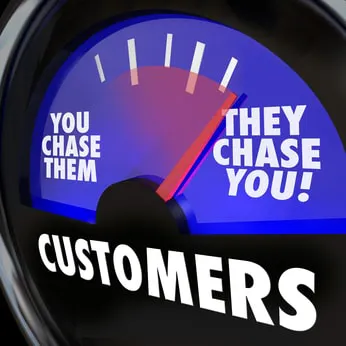What are you doing to make people more aware of your brand and what you offer? Demand generation is what you do to make people aware of your company: it brings people to your website and lets you start to build a connection with them.
It’s not the same thing as lead generation (though it’s common for the two terms to get mixed up). Demand generation comes at a slightly earlier stage of the customer journey than lead generation and involves different types of content.
Demand Generation vs. Lead Generation

When you’re trying to generate more demand for your brand, that primarily means making people aware of what you offer. You’re not – at this stage – aiming to capture their email address. So, demand generation content should be freely accessible. Blog posts, videos, social media posts, and infographics could all work well.
Lead generation goes a step further, turning curious visitors into leads who you can contact. At this stage, you’re producing content that requires the visitor to enter an email address – this might be an ebook, downloadable guide or workbook, white paper, or anything else that you provide when they sign up for your mailing list.
Of course, there might be situations where a potential customer moves quickly through the two stages: someone new to your brand might come across a Facebook post linking to one of your videos, watch the video, then follow the call to action at the end of the video to sign up for your mailing list. But when you’re planning your marketing strategy, you want to be clear about the distinction between what you’re doing to generate demand and what you’re doing to generate leads.
Tips and Best Practices for Demand Generation

If you do a poor job with demand generation, you may well be doing your brand more harm than good. For instance, a hastily written blog post full of typos won’t make a good impression on a first-time visitor – they might well leave your site and remember your brand as one to avoid in the future.
You also don’t want to create loads of great content that no one ever sees, which is a waste of your time and budget.
So it’s crucial to get demand generation right – and that means following these best practices.
#1: Create High-Quality Content
While it’s easy to end up focusing your resources on your lead generation content, you want your freely available content to be just as impressive. Rather than hurrying to create a dozen different videos, infographics, or blog posts, focus your resources on creating a handful of truly great pieces.
As you plan and develop your demand generation content, consider how useful (or entertaining) the content is going to be, how shareable it will be, and how you can use high-quality design and/or production values to give a great first impression of your brand.
#2: Offer Guest Content to Large Blogs
One great way to get your brand more widely known is to get content published on large blogs in your niche. (You can also follow this strategy with podcasts by applying to be a guest on large, relevant podcasts.)
Many large blogs are open to receiving guest posts, which will have a “bio” where you can link to your website or product. You may well be able to include links within the body of the post, too.
Of course, as with any demand generation content, your guest posts should be high-quality. Don’t see this as purely an opportunity for a backlink – see it as an opportunity to get your content seen by an audience of potentially hundreds of thousands.
#3: Partner with Others to Promote Your Content
Partnership marketing means working with one or more other brands. This could be done in a very simple way (perhaps one week, they share a link to your content in their newsletter, and the next week, you do the same for them) or it could involve a much more detailed and long-term collaboration.
“It is not uncommon for small businesses to struggle with their marketing efforts, as they simply don’t have the time, money, or resources to dedicate to the marketing they need to grow. Rather than being a ‘one man show’, by working alongside another business or group of businesses on a specific marketing strategy or campaign, partnership marketing can be a cost-effective way for small businesses to increase brand awareness, customer acquisition, and ultimately grow.”
#4: Figure Out What’s Working
With demand generation, it might be tempting to just get as much content out there as possible and hope for the best. But if you want to use your resources effectively, you need to know what’s working well for you.
This means not only looking at what content gets shared a lot (do make sure you have share buttons in an effective place on your website!) but also considering what content is most likely to lead to a visitor becoming a lead.
For instance, if you have a funny blog post that has loads of shares and that gets lots of traffic, but that people “bounce” away from quickly, that’s probably not nearly so valuable to you as an informative blog post that gets relatively few shares… but that leads to a high percentage of readers entering their email address to get your free ebook.
Demand generation is where you attract new potential customers and get your brand’s name out there. By using the best practices above, you’ll be able to do a great job with your demand generation content – leading to more leads and more customers.
Creating demand for your products and services means getting your brand out there and in front of more potential customers. Install our social media share buttons to make it easy for your website visitors and blog readers to share your amazing content with their friends and connections. They’re easy to install and free to use – and they make it simple for your visitors to share your content with just one click!




